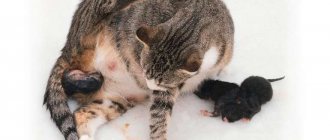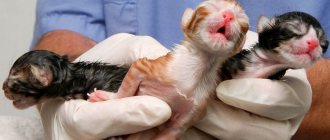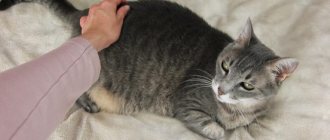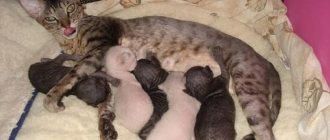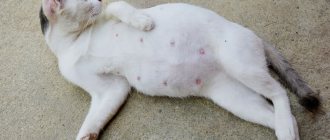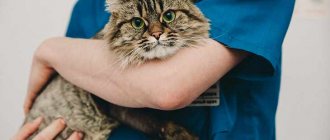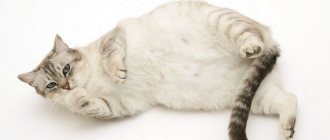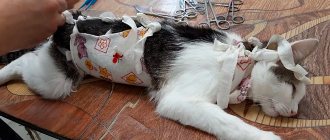How to prepare for the birth of a dog or cat?
Physiology of childbirth in dogs: from A to Z
In this article we will tell you how a normal birth should proceed, when you should and when you shouldn’t worry, in which cases you need to go to the clinic immediately, and when you should just wait.
Do I need to go to the veterinary clinic or call a veterinarian?
Cat giving birth
- This is a normal and natural process. Human intervention should only occur when non-intervention would lead to a problem. Healthy animals give birth on their own and do not require human assistance. This does not mean that childbirth should not be monitored, because childbirth is an unpredictable process, and, unfortunately, sometimes something can go wrong.
How is the pregnancy period going?
The owner of the cat can calculate in advance the approximate date of labor. Pregnancy in animals lasts about 60-65 days. Full-term kittens are born healthy.
If a cat exhibits pathological signs during pregnancy, there is a chance that labor will begin ahead of schedule. To ensure that your pet bears a healthy litter and her pregnancy does not end tragically, be sure to show the cat to the veterinarian throughout the entire pregnancy. This is especially true if pregnancy occurs with complications.
How is childbirth different for pets?
Childbirth in cats
Cats usually give birth faster than dogs.
The harbingers of labor take only a few hours for them; the birth itself and the intervals between babies pass faster. However, if there are complications or abnormal births, they are more likely to end in caesarean section in cats than in dogs.
An important point to know!
Remember that even normal childbirth is extremely stressful for the body. But it is your pet who is giving birth, not you, so you should not increase stress by infecting your pet with your nervousness. No matter how much what is happening scares you, control yourself, talk to the animal in a calm and confident voice, know that it is from you that it expects support. Prepare for childbirth in advance: read the literature, enlist the help of a doctor, find out the number of a 24-hour clinic to be fully prepared.
Do not panic! Animals sense your condition and may become frightened, which can lead to them hiding from you. Create the most calm and comfortable environment for the animal. You shouldn’t grab it and rush to the clinic to give birth if there is no reason for this. Traveling is an additional stress, which, especially in cats, can lead to the cessation of labor. If you are very worried and unsure of your abilities, it is better to invite a doctor to your home. You can call the clinic and get doctor's advice.
We will tell you how a normal, uncomplicated birth proceeds.
How do you know when an animal is due to give birth?
There are even special online calendars on the Internet that are very convenient. Enter the mating date and get the estimated due date. If you are not sure or do not know the exact date, you can do an ultrasound to determine the date. A good diagnostician uses ultrasound to determine the period with an accuracy of up to a week.
However, even the best doctor can make a mistake with the number of fetuses. The fact is that the uterus in animals is two-horned, shaped like the letter V, so during research you can easily make a mistake by counting the same fetus twice. The exact number of babies can only be determined by x-rays, but this method is not recommended for pregnant women. If the owner insists, then he takes the risks for the consequences.
What are contractions from a physiological point of view?
This is the name for involuntary contractions of the uterus (i.e., the cat cannot consciously control them), which contribute to the removal of kittens from the uterine cavity and the passage of cubs through the birth canal.
Always remember one important nuance - the presence of contractions does not always indicate the onset of labor.
Interestingly, the question of what exactly stimulates the immediate onset of labor is still being actively discussed. Researchers note that physiological (normal) labor is stimulated not only by the mother's body, but also by her babies still in the uterine cavity. When a cat’s body is already “mentally ready” for childbirth, its placenta, as well as the kittens’ pituitary glands, begin to secrete a complex mixture of hormones, thanks to which contractions begin.
The complete readiness of the cervix (more precisely, the degree of its opening) is of great importance. Throughout pregnancy, the lumen of this organ is tightly closed due to muscle contraction. The first labor contractions are accompanied by a gradual opening of the cervix and the removal of the remains of the mucous plug from its lumen. The latter is responsible for the complete tightness and sterility of the uterine cavity during pregnancy.
At the same time, the pressure inside the uterus itself gently but constantly continues to increase. This stimulates the movement of the fetuses, which will also subsequently help the cat give birth normally. As a result of this process, the rigidity of the uterine muscles increases. This is also extremely important, since otherwise the animal may develop dystonia or complete atony of the uterine muscles, which will certainly lead to the impossibility of natural birth of cubs.
All the processes described above lead to the fact that the fetal bladders, each of which contains one kitten, begin to gradually be squeezed out towards the exit of the uterus, moving along the birth canal. If everything goes well, and in the second stage of labor the first of the amniotic sacs is clearly visible in the birth canal, it is considered that the cervix has opened to the proper extent and the birth process is proceeding normally.
Contractions in primiparous cats can begin about a day before the start of the second stage of labor (“true”).
The beginning of the second stage is indicated by contractions not only of the uterus itself, but also of the walls of the abdominal cavity, which help push the newborn kittens through the lumen of the birth canal.
Another important circumstance must be taken into account. If contractions of the uterine wall (i.e. contractions themselves) are an involuntary phenomenon, then the cat can control the contractions of the abdominal wall muscles quite consciously. This is precisely what the birth rate is connected with: in primiparous pets who do not yet have childbirth experience, it is much lower. Older animals give birth much faster, since they already know when labor began and how hard they need to strain their muscles. For the same reason, primiparous pets may experience pathologies of the birth process much more often.
Precursors of childbirth and symptoms of an imminent birth of a cat...
External manifestations of imminent labor are called precursors and are similar in dogs and cats.
- Animal behavior,
- lactation,
- appetite,
- frequent urination,
- prolapse of the abdomen,
- loop softening,
- thermometry.
A week before giving birth, the animal’s behavior changes
. This is due to the growth of the hormone estrogen, which causes contraction of the muscle fibers of the uterus (contraction). This increases anxiety and stimulates the animal to build a nest. Dogs begin to dig, cats begin to build a “nest.” It is recommended to provide the animal with a box or house in which it will feel safe.
Lactation
– does not always appear and not for everyone. This is not a completely accurate sign of the harbingers of labor. In some dogs it may appear from the 40th day of pregnancy, and in others only after birth.
Appetite.
In general, the appetite before birth worsens, or may become selective, that is, the animal may become more picky about food.
There are animals that eat even during the birth process, but these are exceptional cases, of course. And some people completely lose their appetite before giving birth, which is a very bad symptom and can lead to ketoacidosis
. If the animal does not eat for more than a day, and labor does not begin, you should consult a doctor. So, everything is individual.
Frequent urination
– normal before labor, usually associated with increased uterine contractions. Urinating in inappropriate places can be an involuntary leakage of urine. Sometimes the animal simply does not have time to “run” or wait until the walk.
«Abdominal prolapse
“- is considered perhaps the surest sign of imminent labor, but it is associated not with the harbingers of labor, but with an increase in the weight of the fetus. The most active weight gain occurs in the last weeks, and the growth of babies continues until the very birth, so the stomach drops under the gravity of the uterus. The more fetuses there are, the more pronounced the prolapse of the uterus is. If the animal has only one fetus, then uterine prolapse may not be noticeable at all.
Loop softening
– she is preparing for childbirth, so she becomes softer and more pliable a couple of days before giving birth.
One of the most accurate precursors of labor is Thermometry
. It is of key importance in determining the period of labor.
For control, it is advisable to measure the temperature 1-2 times a day, starting from the 55th day of pregnancy. When we know what it usually is, we can determine when they will start. A drop in temperature by 2 degrees (to 37) usually indicates the imminent onset of labor.
Physiology of childbirth
In ripened fetuses, cortisol (stress hormone) is formed, which passes the placental barrier, it stimulates the mother’s production of prostaglandins. Prostaglandins dissolve the corpus luteum of pregnancy, which produces the pregnancy hormone progesterone. The amount of progesterone drops sharply and labor begins.
In addition, the amount of estrogens increases, which increases the sensitivity of receptors to oxytocin. The contraction of the uterus increases. The hormone relaxin, produced by the placenta, stimulates the dilatation of the cervix and prepares it for the expulsion of the fetus.
Hormones prolactin and lactation hormone
The hormone prolactin is a “maternal behavior” hormone and a lactation hormone.
Stages of childbirth in detail.
Childbirth is divided into 3 stages, each stage has its own time interval.
The intervals and duration of labor are unpredictable, and past births are not an indicator. One time an animal can give birth in a couple of hours, another time the birth will last almost a day and both options can be the norm.
Stage 1 – harbingers of labor.
This is the most painful stage for the animal and the owner. Behavior changes as the uterus contracts, but we do not see this in the abdomen. The dog (cat) is breathing heavily and digging or making a nest. The period can take up to a day. To confirm the onset of labor in dogs, a progesterone test can be done. Its decrease confirms the onset of labor.
Exception: In cats, progesterone is also produced by the placenta, so the drop in progesterone will not be as significant as in dogs. A strong decrease in cats occurs only the day after birth.
Similarly, in the case of “single puppy/kitten syndrome”, one fetus may not cause such a cascade of reactions, as a result of which pregnancy may be delayed. And there is no decrease in temperature, since progesterone does not drop and labor does not begin for a long time.
The birth process
Kittens ready to be born line up to be born in the animal’s two-horned uterus. The birth process is divided into 3 stages:
- The cat feels contractions of the uterus and at the same time the urge to have a bowel movement. The cervix begins to open slightly. Often at this stage the birth plug comes out along with mucous secretions.
- In the second phase, contractions become more intense and painful, the cervix opens completely, preparing to let the kittens move through the birth canal. The cat strains, trying with all her might to “push through” the cubs. This is how a healthy kitten is born with a favorable course of labor. If the amniotic sac has not burst earlier, the baby is born in it. Usually the woman in labor frees the kitten herself by gnawing the shell. But it happens that she leaves the place of birth in fright or gets lost during the first lambing, and then you must come to the rescue by cutting the bladder with sterile scissors so that the baby does not suffocate. The next cub should emerge 15, maximum 40 minutes after the first.
- At the final stage of labor, the placenta is separated from the mother. The cat must eat one of the nursery places - this will help her quickly realize that she is a mother and speed up lactation. Make sure that after each kitten there is an afterbirth. The placenta remaining in the pet’s body can rot, which will lead to severe inflammation and even death of the animal. At the same time, the cat may eat a stillborn or too weak kitten, which is best avoided.
Well, the birth is over. Make sure your pet has given birth to all the kittens by feeling her belly: it should be soft and empty. If you still have doubts, and the cat is in no hurry to feed and caress the cubs, but still shows signs of anxiety, seek advice from a specialist.
You can also contact our site's staff veterinarian, who will respond to them as soon as possible in the comment box below.
The main signs of the imminent onset of labor:
- Anxiety, tremor, anorexia. Dilated pupils.
- Rapid breathing, sometimes with an open mouth.
- Digging, nest building.
- The temperature is about 36.7–37. The entire first stage of labor persists. By the 2nd stage it will return to normal.
- Vocalization in cats. They walk in circles and lick themselves.
- During this period, the cervix opens inside. There is no effort. There may be weak contractions that are mistaken for pushing.
- Another external manifestation of this stage of labor is the release of the mucus plug. It comes out when the cervix opens, and thick mucous discharge always comes out of the loop. It looks like a long thread hanging from a loop.
In cats, due to their cleanliness and immediate licking of anything that could dirty them, the removal of the plug can be difficult to notice. But often 1-24 hours before birth it can be noticed.
Possible pathologies
The most typical pathology of the birth process, which is directly related to contractions, is dystonia or uterine atony . These disorders do not allow the organ to contract normally, as a result of which the normal birth process is seriously disrupted.
- Such disorders are most common in older cats, as well as animals suffering from obesity.
- Primiparous cats may well experience atony.
- This pathology will almost certainly develop in cases of large fetuses or congenital deformities of kittens: in such situations, the animal’s body will spend all its reserves of energy and nutrients long before the newborn kittens can be pushed through the birth canal.
- This violation is most often encountered by owners of purebred Persian cats, as well as crossbred animals “based on” Persians. We also note that uterine dystonia/atony most often develops during the birth of the first or last kitten.
Below we list the main signs, if they appear, you should immediately contact your veterinarian . Your delay may well lead to the death of both the cat herself and all her kittens. So, these are the symptoms:
- The cat has been having intense, strong contractions for an hour or more, but not a single kitten has been born.
- The interval between contractions is more than half an hour, and they themselves are very sluggish.
- During pushing, the amniotic sac burst, but the kitten itself remains in the lumen of the birth canal for more than 10 minutes. Simply put, in cases where the baby being born is simply stuck.
- Each contraction is accompanied by a flow of blood from the lumen of the external genitalia.
- The cat is apathetic and almost does not react to irritating environmental factors; already born kittens are very weak.
- A cat's body temperature that rises to 40° Celsius or drops below 36° Celsius does not indicate anything good. Note, however, that a few hours before giving birth, the body temperature of a pregnant cat always drops to approximately 37.3° Celsius, and this is not considered a pathology.
- When labor seems to have stopped, but at the same time the cat’s stomach tenses from time to time, and the animal itself is either completely apathetic (she may not react at all to what is happening), or is worried, meows anxiously and pays almost no attention to the already born cubs. All of these signs may indicate the presence of “extra” kittens in the uterus. If the cat is not helped within an hour, the cubs will almost certainly die.
- The normal interval between the birth of kittens is from 15 minutes to an hour. No more than 20 minutes should pass from the rupture of the amniotic sac to the appearance of the first kitten. If this time increases significantly, it would not hurt to call a veterinarian. This is especially true in cases where the cat is excited, meows strongly and protractedly, and exhibits other signs that may indicate a strong pain reaction.
